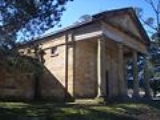
Court houses in New South Wales
Encyclopedia
Court houses in New South Wales were designed by the Colonial Architect, later known as the Government Architect
.
in New South Wales have jurisdiction to deal with:
Local Courts also provide the following services:
. The first Charter of Justice also created a Court of Civil Jurisdiction
to hear and determine in a summary way all pleas relating to real and personal property, debts, contracts, grant of probates and to administer intestate estates. Magistrates appointed in the early years of the colony were unpaid honorary appointments. The first paid magistrate was D'Arcy Wentworth
appointed in 1810.
Local Courts were known as Courts of Petty Sessions. Such courts had originated in England in the fourteenth century. Although during the early years of the colony references are made to Courts of Petty Session sittings by Magistrates, it was not until 1832 that Courts of Petty Sessions were formally established in New South Wales.
The first Courts of Petty Sessions were proclaimed in the Government Gazette of 3 October 1832. The proclamations gave notice that Courts of Petty Sessions were to be held at the following locations: Sydney (Police Office and Hyde Park Barracks
), Inverary, Parramatta, Bathurst, Windsor
, Newcastle, Penrith, Paterson's Plains, Liverpool, Maitland, Campbelltown, Darlington, Wollongong, Invermein, Stonequarry Creek, Port Stephens, Bong Bong or Berrima, Port Macquarie, Goulburn Plains.
More than three hundred court houses have been built in New South Wales since settlement. The oldest existing Local Court in New South Wales is the Local Court at Windsor which was built in 1821.
In 1985 the Local Courts Act abolished Courts of Petty Sessions by changing their name to Local Courts and appointments are now made under that Act. There are currently 160 Local Courts
established throughout New South Wales and 130 Magistrates appointed.
was the Colonial Architect, his office was responsible for designing and building 130 court houses across New South Wales. Some of these replaced existing court houses where it was deemed the building had been outgrown.
New South Wales Government Architect
The New South Wales Government Architect is an officer of the New South Wales government. Historically, the government architect was in charge of the state government's public building projects....
.
Current role
Local CourtsLocal Court of New South Wales
There are over 160 Local Courts in New South Wales. Local Court cases are heard by a magistrate without a jury. It hears summary offences as well as indictable offences and committal hearings. It hears civil claims up to $100,000 and has a Small Claims Division for claims less than $10,000. It...
in New South Wales have jurisdiction to deal with:
- most criminal and summary prosecutions
- civil matters with a monetary value of up to $60,000
- committal hearings
- family law matters
- child care proceedings
- juvenile prosecutions and care matters
- coronial inquiries
- industrial matters
- mining matters
Local Courts also provide the following services:
- Court Registries administer the sittings of the Local Court and provide registry services to the Court's clients.
- The Chamber Magistrate provides information about legal options and court proceedings, but cannot represent people appearing before the Court. In smaller Courts, the Chamber Magistrate service is often provided by the Clerk of the Court.
- Coroners hold inquests into deaths and inquiries into fires. Outside the metropolitan area, most Clerks of the Local Court are appointed as Coroners for the State.
- Marriage Celebrant: Clerks of the Local Court at most country registries (and some larger metropolitan registries) are authorised to perform marriages.
- Licensing: Most major country and outer metropolitan registries process applications for and issue certain licences such as a liquor licence or commercial agents licence.
History of New South Wales Local Courts
The first New South Welsh Charter of Justice of 2 April 1787 created the power to convene a criminal court. This was the Court of Criminal JurisdictionCourt of Criminal Jurisdiction
The Court of Criminal Jurisdiction was a criminal court established in 1787 under the auspices of the First Charter of Justice in the British Empire of New South Wales, now a state of Australia. The Court of Criminal Jurisdiction was the first criminal court in the colony...
. The first Charter of Justice also created a Court of Civil Jurisdiction
Court of Civil Jurisdiction
The Court of Civil Jurisdiction was a court established in the late 18th century in the colony of New South Wales which subsequently became a state of Australia. The court had jurisdiction to deal with all civil disputes in the then fledgling colony...
to hear and determine in a summary way all pleas relating to real and personal property, debts, contracts, grant of probates and to administer intestate estates. Magistrates appointed in the early years of the colony were unpaid honorary appointments. The first paid magistrate was D'Arcy Wentworth
D'Arcy Wentworth
D'Arcy Wentworth was born in Portadown, County Armagh, Ireland and emigrated to Australia as an assistant surgeon to then-new colony of Sydney.- Emigration to Australia :...
appointed in 1810.
Local Courts were known as Courts of Petty Sessions. Such courts had originated in England in the fourteenth century. Although during the early years of the colony references are made to Courts of Petty Session sittings by Magistrates, it was not until 1832 that Courts of Petty Sessions were formally established in New South Wales.
The first Courts of Petty Sessions were proclaimed in the Government Gazette of 3 October 1832. The proclamations gave notice that Courts of Petty Sessions were to be held at the following locations: Sydney (Police Office and Hyde Park Barracks
Hyde Park Barracks, Sydney
The Hyde Park Barracks is an internationally significant, impressive brick building and compound designed by convict architect Francis Greenway between 1818–19; originally built at the head of Macquarie Street to house convict men and boys....
), Inverary, Parramatta, Bathurst, Windsor
Windsor, New South Wales
Windsor is a town in the state of New South Wales, Australia. Windsor is located in the local government area of the City of Hawkesbury. It sits on the Hawkesbury River, on the north-western outskirts of the Sydney metropolitan area. At the 2006 census, Windsor had a population of...
, Newcastle, Penrith, Paterson's Plains, Liverpool, Maitland, Campbelltown, Darlington, Wollongong, Invermein, Stonequarry Creek, Port Stephens, Bong Bong or Berrima, Port Macquarie, Goulburn Plains.
More than three hundred court houses have been built in New South Wales since settlement. The oldest existing Local Court in New South Wales is the Local Court at Windsor which was built in 1821.
In 1985 the Local Courts Act abolished Courts of Petty Sessions by changing their name to Local Courts and appointments are now made under that Act. There are currently 160 Local Courts
Local Court of New South Wales
There are over 160 Local Courts in New South Wales. Local Court cases are heard by a magistrate without a jury. It hears summary offences as well as indictable offences and committal hearings. It hears civil claims up to $100,000 and has a Small Claims Division for claims less than $10,000. It...
established throughout New South Wales and 130 Magistrates appointed.
Court houses built from 1788 - 1862
| The oldest existing Local Court in New South Wales is the Local Court at Windsor Windsor, New South Wales Windsor is a town in the state of New South Wales, Australia. Windsor is located in the local government area of the City of Hawkesbury. It sits on the Hawkesbury River, on the north-western outskirts of the Sydney metropolitan area. At the 2006 census, Windsor had a population of... which was built in 1821. The plan and specifications for the Windsor Court House were prepared by the Colonial architect, Francis Greenway Francis Greenway -References:* *... . The Court House was built for a sum of 1,800 pounds by William Cox, who also served there as a magistrate. |
|
 |
Court house at Berrima Berrima, New South Wales Berrima is an historic village in the Southern Highlands of New South Wales, Australia, in Wingecarribee Shire. The village, once a major town, is located on the Old Hume Highway between Canberra and Sydney. It was previously known officially as the Town of Berrima... built between 1833 and 1838. It was designed by the Colonial Architect New South Wales Government Architect The New South Wales Government Architect is an officer of the New South Wales government. Historically, the government architect was in charge of the state government's public building projects.... , Mortimer Lewis Mortimer Lewis Mortimer William Lewis , was an English architect and surveyor who migrated to Australia and became Colonial Architect in the state of New South Wales from 1835 to 1849. Lewis was responsible for designing and overseeing many government buildings in Sydney and rural New South Wales, many of which... , in the Roman style. Four Doric columns Doric order The Doric order was one of the three orders or organizational systems of ancient Greek or classical architecture; the other two canonical orders were the Ionic and the Corinthian.-History:... support a Classical Classical architecture Classical architecture is a mode of architecture employing vocabulary derived in part from the Greek and Roman architecture of classical antiquity, enriched by classicizing architectural practice in Europe since the Renaissance... pediment Pediment A pediment is a classical architectural element consisting of the triangular section found above the horizontal structure , typically supported by columns. The gable end of the pediment is surrounded by the cornice moulding... . The building is now stylistically classified as Georgian design. It is built of sandstone. There were a number of problems in building the court house; the first architect had resigned and three builders were involved. The first quarter sessions were held at the court house in 1841. In 1843, the first trial by jury Jury trial A jury trial is a legal proceeding in which a jury either makes a decision or makes findings of fact which are then applied by a judge... in the colony of New South Wales was held here. The assize courts were only continued for seven years. In 1850 the district court moved to Goulburn Goulburn, New South Wales Goulburn is a provincial city in the Southern Tablelands of New South Wales, Australia in Goulburn Mulwaree Council Local Government Area. It is located south-west of Sydney on the Hume Highway and above sea-level. On Census night 2006, Goulburn had a population of 20,127 people... south of Berrima. Minor courts continued at Berrima until 1873. Notable trials were of John Lynch who was hung for the murder of at least nine people, and of Lucretia Dunkley and her lover Martin Beach who were both were hanged in 1843 for the murder of Dunkley’s husband. Dunkley was the only woman hanged at Berrima gaol Berrima Correctional Centre Berrima Correctional Centre is an Australian female prison located at Berrima, New South Wales, Australia. Berrima Gaol is the oldest gaol still in operation in Australia.... . |
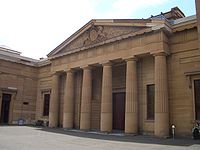 |
Darlinghurst Darlinghurst, New South Wales Darlinghurst is an inner-city, eastern suburb of Sydney, in the state of New South Wales, Australia. Darlinghurst is located immediately east of the Sydney central business district and Hyde Park, within the local government area of the City of Sydney... Courthouse is an imposing sandstone building on Taylor Square. It was designed by Mortimer Lewis in 1844, and has a Greek Revival style facade. The central block is adapted from an 1823 design in Peter Nicholson's 'The New Practical Builder'. |
| |Dungog court house was built in 1849 when the police barracks were converted, replacing a previous 1836 courthouse. It has been much added to since but remains the oldest Courthouse outside Sydney still in use. | |
| |Wollongong court house was built in 1858 and stands opposite the harbour. It was used for naval purposes until recently being converted to other purposes such as hosting the local annual orchid show. | |
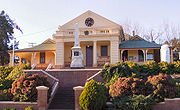 |
Gundagai Gundagai, New South Wales Gundagai is a town in New South Wales, Australia. Although a small town, Gundagai is a popular topic for writers and has become a representative icon of a typical Australian country town... Court House, completed in 1859, was one of the first stone buildings to be erected after the Gundagai floods of 1852 and was the site for the trial of Captain Moonlite (the bushranger Andrew George Scott). The interior, originally red cedar, was destroyed by a fire in 1943 and rebuilt with mountain ash. The monument in front of the building is a Boer War memorial. |
 |
Albury Albury, New South Wales Albury is a major regional city in New South Wales, Australia, located on the Hume Highway on the northern side of the Murray River. It is located wholly within the boundaries of the City of Albury Local Government Area... completed 1860. This court house was designed by the Colonial Architect Alexander Dawson in the palladian style Palladian architecture Palladian architecture is a European style of architecture derived from the designs of the Venetian architect Andrea Palladio . The term "Palladian" normally refers to buildings in a style inspired by Palladio's own work; that which is recognised as Palladian architecture today is an evolution of... . It was built out of local grey granite by Thomas Allen of Albury. In the press gallery there has been a tradition of journalists to carve their names. The first Clerk of Petty Sessions was John Roper, who had been a member of Leichhardt's 1844 expedition. |
Court houses built from 1862 - 1890
During the period that James BarnetJames Barnet
James Johnstone Barnet was the Colonial Architect for New South Wales from 1862 - 1890.-Life and career:Barnet was born at Almericlose, Arbroath, Scotland. The son of a builder, he was educated at the local high school...
was the Colonial Architect, his office was responsible for designing and building 130 court houses across New South Wales. Some of these replaced existing court houses where it was deemed the building had been outgrown.
| Holbrook Holbrook, New South Wales Holbrook is a small town in Southern New South Wales, Australia. It is on the Hume Highway, 356 km North-East of Melbourne and 491 km south-west of Sydney between Tarcutta and Albury. The town is in the Greater Hume Shire Council area which was established in May 2004 from the merger of... completed in 1873. |
|
.jpg) |
Glen Innes Glen Innes, New South Wales Glen Innes is a parish and town on the Northern Tablelands, in the New England region of New South Wales, Australia. It is the centre of the Glen Innes Severn Shire Council. The town is located at the intersection of the New England Highway and the Gwydir Highway... Court House was built in 1873. |
 |
Gundaroo Gundaroo, New South Wales Gundaroo is a small village in the Southern Tablelands of New South Wales, Australia and in Yass Valley Council. It is situated to the east of the Yass River, about north of Sutton, about west of the Lake George range. At the 2006 census, Gundaroo had a population of 331.The explorers Charles... The Court House in Cork Street was built in 1875. A solid high-ceilinged structure, it was in use until 1934. In 1940 it was sold to the Anglican Church and became St Mark's Church in 1941. |
| Tumut Tumut, New South Wales Tumut is a town in the Riverina region of New South Wales, Australia, situated on the banks of the Tumut River. Tumut is at the foothills of the Snowy Mountains and is referred to as the gateway to the Snowy Mountains Scheme... Court House was completed in 1878 and the Stables in 1879. The adjacent Police Station had been completed in 1874. The Court House and Police Station are characterised by a hip roof and timber verandah posts. |
|
| Gunning Gunning, New South Wales Gunning is a town on the Old Hume Highway, between Goulburn and Yass in the Southern Tablelands of New South Wales, Australia, about 260 km south-west of Sydney and 75 km north of the national capital, Canberra. On Census night 2006, Gunning had a population of 487 people... was completed in 1879. It was built onto the lock-up keeper's residence, which had been erected seven years earlier. It is a painted brick building with a hipped roof, clad in corrugated iron; the chimneys are topped by chimney pots. The front verandah has plain timber posts. The original cedar joinery on the inside of the building is intact. The double-height courtroom is flanked on either side by a single storey office wing (police station and office of the clerk of petty sessions). |
|
| Cowra Cowra, New South Wales Cowra is a town in the Central West region of New South Wales, Australia in the Cowra Shire. It is located on the Mid-Western Highway, 317 kilometres west of Sydney on the banks of the Lachlan River at an altitude of 310 metres above sea level. At the 2006 census Cowra had a population of 8,430... - a Federation-style brick building with unusual gable ends. It is a symmetrical building with a distinctive double-height court room and Roman arches. It was completed in 1879. |
|
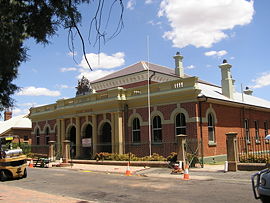 |
Forbes Forbes, New South Wales -Notable residents:*Carolyn Simpson - Judge of the Supreme Court of New South Wales; Member of the first all-female bench to sit in an Australian court*NSW Deputy Premier Carmel Tebbutt was born and raised in Forbes.... - a Classical Revival courthouse completed in 1880. |
| Bathurst Bathurst, New South Wales -CBD and suburbs:Bathurst's CBD is located on William, George, Howick, Russell, and Durham Streets. The CBD is approximately 25 hectares and surrounds two city blocks. Within this block layout is banking, government services, shopping centres, retail shops, a park* and monuments... Court House was completed in 1880. It is in the Neo-Classical style with an octagonal Renaissance dome. The wings, built as the postal and telegraph offices, were opened in 1877. The entire structure is 81 metres long and 45 metres wide. The west wing is now occupied by the Central Western Music Centre. The east wing is now the Historical Society Museum. |
|
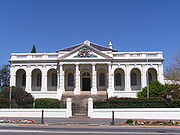 |
A court of petty sessions was first established at Yass Yass, New South Wales Yass is a town in the Southern Tablelands of New South Wales, Australia in Yass Valley Shire. The name appears to have been derived from an Aboriginal word, "Yarrh" , said to mean 'running water'.... in 1836. The present court house was opened in 1880. |
| Boorowa Boorowa, New South Wales Boorowa is a farming town in the South West Slopes of New South Wales, Australia. At the 2006 census, Boorowa had a population of 1,070 people. It is located in a valley 243 km west of Sydney and 487 m above sea-level... completed 1884. It is a symmetrical building with a distinctive double-height court room and Roman arches. |
|
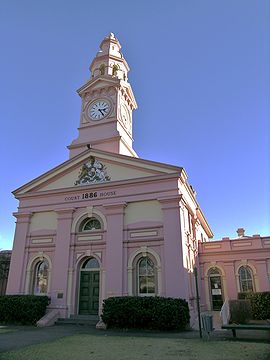 |
Inverell Inverell, New South Wales Inverell is a town in northern New South Wales, Australia, situated on the Macintyre River. It is also the centre of Inverell Shire. Inverell is located on the Gwydir Highway on the western slopes of the Northern Tablelands. It has a temperate climate... court house was completed in 1886. |
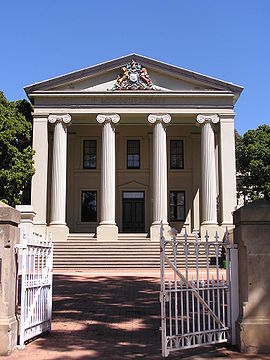 |
Young Young, New South Wales -Demographics:On census night, 7 August 2001, there were 6,821 people counted in Young. There were 238 people who identified as being of Indigenous origin in the 2001 Census... Court House completed in 1886. It is in the High Victorian Classical style. The building is now used as a school assembly hall. |
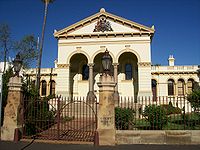 |
Dubbo Court House completed in 1887. |
 |
Goulburn Goulburn, New South Wales Goulburn is a provincial city in the Southern Tablelands of New South Wales, Australia in Goulburn Mulwaree Council Local Government Area. It is located south-west of Sydney on the Hume Highway and above sea-level. On Census night 2006, Goulburn had a population of 20,127 people... opened 1887. Italianate style, designed by the Colonial Architect James Barnet. |
| Cooma Cooma, New South Wales -Education: is Cooma's only public high school, it serves the town and seven of the neighbouring rural towns and villages such as Berridale, Jindabyne, Nimmitabel, Bredbo and Dalgety.... court house completed in 1889. It has shuttered french windows and a front verandah. |
|
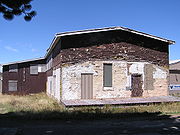 |
The first Kiandra Kiandra, New South Wales Kiandra is an abandoned gold mining town and the birthplace of Australian skiing. The town is situated in the Snowy Mountains of New South Wales, Australia, in the Snowy River Shire inside the Kosciuszko National Park. Its name is a corruption of Aboriginal 'Gianderra' for 'sharp stones for... court house was built in 1860 as part of the Police Commissioner's Camp. By the 1870s the building was being used as a barn. The second court house, which also served as the local lock-up and the police headquarters, was completed in 1890 and built from local basalt. |
| Junee Junee, New South Wales Junee is a medium sized town in the Riverina region of New South Wales, Australia. The town's prosperity and mixed services economy is based on a combination of agriculture, rail transport, light industry and government services, and in particular correctional services... court house was designed by James Barnett (Government Architect) and was built in 1890. |
Court houses built from 1890 - present
 |
Braidwood Braidwood, New South Wales Braidwood is a town in the Southern Tablelands of New South Wales, Australia, in Palerang Shire. It is located on the busy Kings Highway linking Canberra to Batemans Bay on the coast. It is about 200 kilometres south west of Sydney and about 60 kilometres inland from the coast... built 1900, a Federation single-storey brick building, characterised by four Doric columns. The first court house in Braidwood had been built in 1837 by Dr Wilson. |
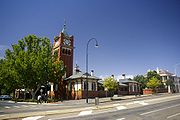 |
Wagga Wagga Wagga Wagga, New South Wales Wagga Wagga is a city in New South Wales, Australia. Straddling the Murrumbidgee River, and with an urban population of 46,735 people, Wagga Wagga is the state's largest inland city, as well as an important agricultural, military, and transport hub of Australia... built in 1900, an Edwardian complex with massive square clock tower, belltower, cupolas, decorative iron work and cedar joinery and fittings. A police building and court premises were established in Wagga Wagga 1847. |
| Condobolin Condobolin, New South Wales Condobolin is a town in the west of the Central West region of New South Wales, Australia, on the Lachlan River. At the 2006 census, Condobolin had a population of 2,847.- History :... built 1902. |
|
 |
Temora Temora, New South Wales Temora is a town located in north east part of the Riverina area of New South Wales, south-west of the state capital, Sydney. At the 2006 census the population of Temora was 4,086.-History:... built 1902. |
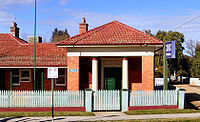 |
Culcairn Culcairn, New South Wales Culcairn is a town in the south east Riverina region of New South Wales, Australia. Culcairn is located in the Greater Hume Shire Council Local government area on the Olympic Highway between Albury and Wagga Wagga... built 1926. The establishment of a police presence in Culcairn was announced in the Wagga Wagga Advertiser on 17 January 1891. The police rented premises until a combined police station/courthouse and residence was built. |
| Leeton Leeton, New South Wales Leeton is a town in the Riverina region of New South Wales, Australia. Leeton is situated approximately 550 km west of Sydney and 450 km north of Melbourne in the productive Murrumbidgee Irrigation Area. Leeton is administered by Leeton Shire Council... court house built in 1943. |
|
| Narooma Narooma, New South Wales Narooma is a town in the Australian state of New South Wales on the far south coast. The town is on the Princes Highway. The name is said to be derived from the Aboriginal word meaning ‘clear blue waters’. At the 2006 census, Narooma had a population of 3,100 people.Montague Island, a National... court house was criticised as being the "smallest in the country" in 2004. At that time 11 Indigenous Australians Indigenous Australians Indigenous Australians are the original inhabitants of the Australian continent and nearby islands. The Aboriginal Indigenous Australians migrated from the Indian continent around 75,000 to 100,000 years ago.... were on trial over a claim on fishing rights based on cultural and religious practices. The case was being heard over several weeks and it was reported that "There is no room for the men to sit in court when researchers and members of the public are present. Apart from a small wind exposed verandah there is no other shelter. There are no interviewing facilities for their lawyers who are crammed into a room which can only be described as a dog box." The court moved from Eurobodalla to Narooma in 1895. |

